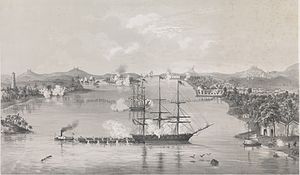
The Second Opium War, also known as the Second Anglo-Chinese War or Arrow War, was fought between the United Kingdom and France against the Qing dynasty of China between 1856 and 1860. It was the second major conflict in the Opium Wars, which were fought over the right to import opium to China, and resulted in a second defeat for the Qing Mandate and the forced legalization of the opium trade. It caused many Chinese officials to believe that conflicts with the Western powers were no longer traditional wars, but part of a looming national crisis.

The Asiatic Squadron was a squadron of United States Navy warships stationed in East Asia during the latter half of the 19th century. It was created in 1868 when the East India Squadron was disbanded. Vessels of the squadron were primarily involved in matters relating to American commerce with China and Japan, though it participated in several conflicts over 34 years of service until becoming the Asiatic Fleet in 1902.
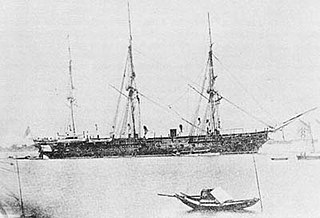
The first USS Colorado, a 3,400-long-ton (3,500 t), three-masted steam screw frigate, was launched on 19 June 1856, by the Norfolk Navy Yard. Named after the Colorado River, she was sponsored by Ms. N. S. Dornin, and commissioned on 13 March 1858, with Captain W. H. Gardner, in command. She was the fifth of the Franklin-class frigates, which were all named after US rivers, except for Franklin.

Andrew Hull Foote was an American naval officer who was noted for his service in the American Civil War and also for his contributions to several naval reforms in the years prior to the war. When the war came, he was appointed to command of the Western Gunboat Flotilla, predecessor of the Mississippi River Squadron. In that position, he led the gunboats in the Battle of Fort Henry. For his services with the Western Gunboat Flotilla, Foote was among the first naval officers to be promoted to the then-new rank of rear admiral.

The second USS Portsmouth was a wooden sloop-of-war in the United States Navy in service during the mid-to-late 19th century. She was designed by Josiah Barker on the lines of a French-built privateer, and built at the Portsmouth Navy Yard, directly across the Piscataqua River from Portsmouth, New Hampshire. She was described as an improvement over USS Saratoga built in the same shipyard a year earlier. Portsmouth was launched on 23 October 1843 and commissioned on 10 November 1844, with Commander John Berrien Montgomery in command.
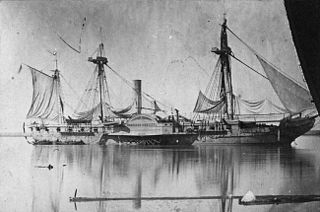
USS Mississippi, a paddle frigate, was the first ship of the United States Navy to bear that name. She was named for the Mississippi River. Her sister ship was Missouri. Her keel was laid down by the Philadelphia Navy Yard in 1839; built under the personal supervision of Commodore Matthew Perry. She was commissioned on 22 December 1841, with Captain W. D. Salter in command and launched several weeks later.
The first USS Levant was a second-class sloop-of-war in the United States Navy.

The Pacific Squadron of the United States Navy, established c. 1821 and disbanded in 1907, was a naval squadron stationed in the Pacific Ocean in the 19th and early 20th centuries.
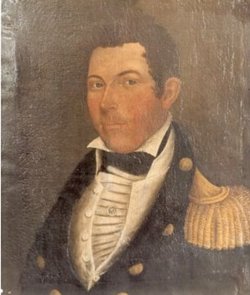
Commodore James Armstrong was an officer in the United States Navy.

The Mediterranean Squadron, also known as the Mediterranean Station, was part of the United States Navy in the 19th century that operated in the Mediterranean Sea. It was formed in response to the First and Second Barbary Wars. Between 1801 and 1818, the squadron was composed of a series of rotating squadrons. Later, squadrons were sent in the 1820s to the 1860s to suppress piracy, primarily in Greece and to engage in gunboat diplomacy. In 1865 the force was renamed the European Squadron.
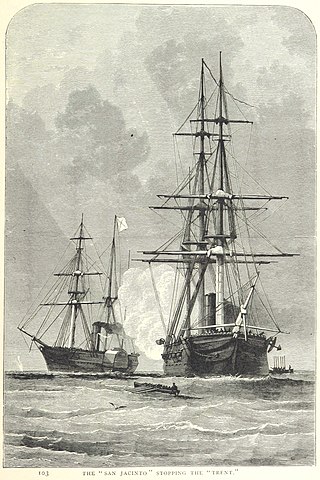
The first USS San Jacinto was an early screw frigate in the United States Navy during the mid-19th century. She was named for the San Jacinto River, site of the Battle of San Jacinto during the Texas Revolution. She is perhaps best known for her role in the Trent Affair of 1861.

William Maxwell Wood was an officer and surgeon in the United States Navy in the middle 19th century. He became the First Surgeon General of the U.S. Navy in 1871, with the equivalent rank of commodore. He rose to president of the examining board in 1868 and chief of the U.S. Navy Bureau of Medicine and Surgery in 1870 following his service in the American Civil War as Fleet Surgeon of the North Atlantic Blockading Squadron aboard the USS Minnesota and Medical Officer of the James River Flotilla, participating in several famous Naval battles, and establishing temporary hospitals as needed during the Civil War.

The East India Squadron, or East Indies Squadron, was a squadron of American ships that existed in the nineteenth century. It focused on protecting American interests in the Far East, while the Pacific Squadron concentrated on the western coasts of the Americas and the South Pacific Ocean. Its duties included the Yangtze River Patrol in China. The East India Squadron was established in 1835 and existed until it became part of the Asiatic Squadron in 1868.
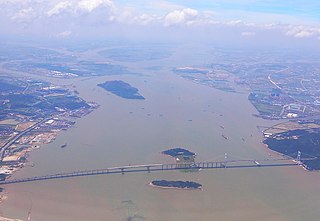
The Humen, also known as the Bocca Tigris or the Bogue, is a narrow strait in the Pearl River Delta that separates Shiziyang in the north and Lingdingyang in the south. It is located near Humen Town in China's Guangdong Province. It is the site of the Pearl River's discharge into the South China Sea. It contains the Port of Humen at Humen Town. The strait is formed by the islands of Chuenpi and Anunghoy on the eastern side, and Taikoktow on the western side. Since 1997, the strait has been traversed by the Humen Pearl River Bridge. Bocca Tigris was the entry to China's only trading city, Canton.

HMS Wellesley was a 74-gun third rate, named after the Duke of Wellington, and launched in 1815. She captured Karachi for the British, and participated in the First Opium War, which resulted in Britain gaining control of Hong Kong. Thereafter she served primarily as a training ship before gaining the distinction of being the last British ship of the line to be sunk by enemy action and the only one to have been sunk by an air-raid.
Admiral Sir Henry Smith was a British officer in the Royal Navy. He commanded the Aden Expedition in 1839 which took Aden as the first colonial acquisition of the reign of Queen Victoria. For this service he was appointed a Companion of the Order of the Bath. Smith was then sent to serve on the China Station, where he fired the first shot of the First Opium War at the Battle of Kowloon. He played an important role at the controversial Battle of Chuenpi later in the year, and as senior naval officer on the south coast of China fought the Battle of the Barrier. He later participated in the Battles of Second Chuenpi, the Bogue, and Canton, before forming part of the Amoy garrison after the Battle of Amoy. Having left China in 1843, he went on to command ships in the Mediterranean and then in the Baltic Sea during the Crimean War. Smith never served at sea again after obtaining flag rank in 1855 but became superintendent of the Royal Hospital Haslar and the Royal Clarence Yard. He was appointed a Knight Commander of the Order of the Bath in 1873, retiring in the same year.

Rear Admiral George Henry Cooper was an officer in the United States Navy. During his long naval career, he served on the African Slave Trade Patrol, and fought in the Second Seminole War, the Mexican War, the American Civil War, and the Korean Expedition, and rose to command of the North Atlantic Squadron.

HMS Encounter was ordered as a First-Class Sloop with screw propulsion on 5 February 1845 to be built at Pembroke, in accordance with the design developed by John Fincham, Master Shipwright at Portsmouth. Her armament was to consist of 8 guns. She was to have a more powerful steam engine rated at 360 nominal horsepower. In 1848 she would be altered abaft and lengthened at Deptford prior to completion. A second vessel (Harrier) was ordered on 26 March 1846 but after her keel was laid at Pembroke Dockyard, her construction was suspended on 9 September 1846 then cancelled five years later, on 4 April 1851. Encounter had her armament radically altered in 1850 and she was broken up at Devonport in 1866.

The Battle of Canton was fought between British and Chinese forces at the city of Canton (Guangzhou), Guangdong province, China on 23 October to 5 November 1856 during the Second Opium War.

The Battle of Escape Creek was a naval engagement fought between the United Kingdom's Royal Navy and the Qing Chinese naval force on 25–27 May 1857 during the Second Opium War. Commodore Charles Elliot's squadron chased the war-junks at Escape Creek and then, once the British ships were grounded as the river narrowed, they chased them in the ships' boats until all the junks had been overhauled.
